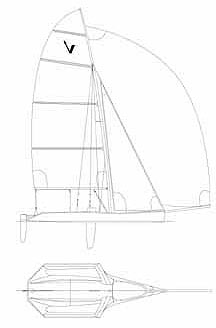Vanguard Vector
One design dinghyr
My own recent experiences racing a Tasar dinghy with my wife were often humbling. But I'm now an even better sailor because of those mind-expanding, ego-deflating moments. If you came to sailing late and your first boat was a 28-footer or a 34-footer, do yourself a favor. Buy, rent, borrow or steal a planing dinghy and go out and put yourself at the low end of the learning curve. You will never regret it, at least not once you dry out.
Maybe the trick is to buy a Vanguard Vector for your kid. Let him go out and learn the boat. Then, when your kid has mastered whatever is needed to keep the Vector upright, you agree to go along as crew.
Better yet, you drive and let your kid go through the athletics of keeping the boat on its pointed little feet. Before long you will have mom out on the trapeze and you will be sitting back tiller in one hand, mainsheet in the other hollering as you blast-reach on a full plane into the marina.
The first thing you need to master with the Vector is how to keep it from capsizing while it sits at the dock. It's hard to look cool while your boat is laying sideways. (I never actually had this happen with my Tasar, but there were moments when I uttered the universal sailor's prayer, "Holy #$%!" as I struggled to belly crawl my way to the dock from a less than stable platform.) The Vector is a light and lively 200 pounds, and you had better keep one hand on the shroud if you want to keep it in a dignified position before shoving off.
Once you're on your way and finished short-tacking through the cut to open water, you finally begin to relax. Now you can get that mainsheet adjusted so the boom is over the quarter. Your mate has finally made it all the way out in the trapeze, and the jib is actually in and not just happily flapping away. Your Vector is beginning to accelerate. For pretty much for the first time the boat is under your control. Hardening up slightly you begin to find some real enjoyment. The boat even feels kind of stable as long as your crew adjusts his position to the changing heel angles. It wants to go in a straight line so you can stop worrying about steering and study your mainsail shape. Maybe it's time to ooch yourself out onto the trapeze so you can sheet in the rest of the main.
Then, finally, you are out on the wire and looking back at the boat almost like you are an observer of the whole thing. You're out here. The boat is down there. You can actually watch the boat move through the water from a removed perspective.
Bearing off you extend the bowsprit and the chute goes up. Then you sheet in the big sail and your Vector accelerates a little quicker than you had in mind. But the funny thing is that as the boat picks up speed things begin to settle down even more. The faster you go the more stable the Vector feels. Before you can say "Uffa Fox" you are planing off on what has become a beam reach.
Back at the marina entrance you look at your mate and after figuring out how to get the chute down you harden up and head up the bay again for another couple more tacks that will take you far enough upwind to get the chute up again. It's wet, it's scary at times, but it sure is fun and you can look right down your nose at the couple in the 35-footer with the jib halyard wrapped around the headstay and three fenders dangling. Who cares if you capsize the Vector at the dock a couple of times as you unrig the boat. You've earned the right to laugh at yourselves.

Comments